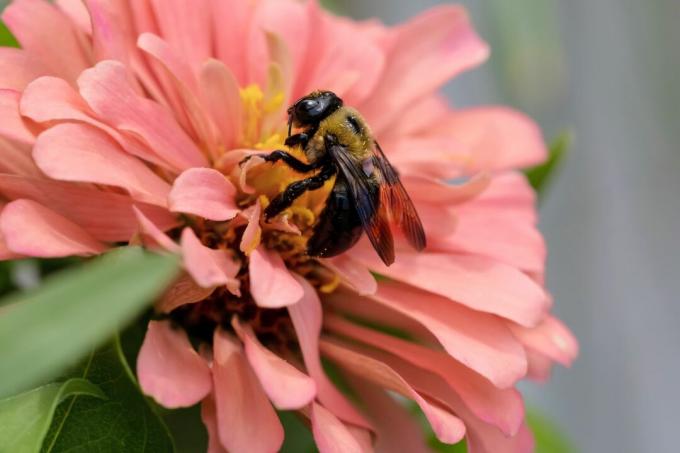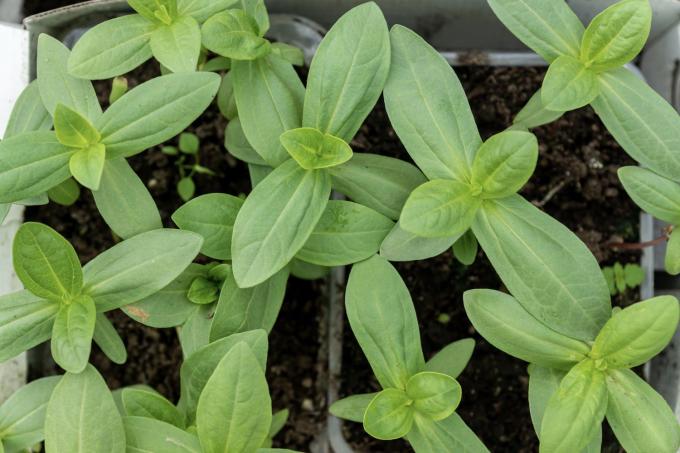Zinnias have always been popular summer flowers and are a real delight for every gardener with their variety of colors and their ability to bloom. We introduce the zinnia and give tips for cultivating it in your own garden.

A summer flower that can be found in almost every cottage garden is the zinnia (Zinnia elegans). It is sometimes used as a cut flower, as it produces numerous colorful flowers over the summer. In this article you will learn everything about the zinnia, its properties, its requirements for location and care, as well as details about sowing and planting.
"Contents"
- Zinnias: origin and characteristics
- The most beautiful zinnias varieties and species
-
Plant zinnias
- The right time to plant zinnias
- The right location for zinnias
- Sow, prick and plant zinnias
- Care of zinnias
- Hibernating zinnias: are zinnias hardy?
- Zinnias propagate
- Common pests on zinnias
- Are zinnias poisonous?
Zinnias: origin and characteristics
The zinnia belongs to the large Asteraceae family - just like daisies (Bellis perennis) and Dahlias (Dahlia). In the genus Zinnia there are about 20 species that grow annual, perennial or as subshrubes. We mainly plant Zinnia elegans. This annual summer flower is originally from Mexico and is also found in other areas of Central and South America. The zinnia was named by the famous Swedish botanist Carl von Linné in honor of the Göttingen anatomist and botanist Johann Gottfried Zinn.
The zinnia is an annual summer flower that grows upright and bushy. The leaves of the zinnia are characteristically covered with short hairs and therefore feel rough. They sit opposite directly on the flower stalk and are roughly triangular in shape. At the end of the stem a terminal flower forms, which depending on the variety is filled or simple and be colored in many colors from white to yellow, orange and red tones to dark pink can. However, strong colors fade quickly in strong sunlight. The flowering time of the zinnias extends from July to September, occasionally even into October.
tip: Zinnias are bee-friendly ornamental flowers as they provide nectar to avid pollinators such as bees, bumblebees and butterflies. The zinnia flower compensates for the relatively small amount of sugary juice per blossom with its high flowering potential.

The most beautiful zinnias varieties and species
If you want to plant zinnias, there is a huge selection of varieties and also a few different species of the genus Zinnia. They differ mainly in the color, shape and size of the flowers and the height of growth. While you can also fall back on tall cultivars when planting beds, small-sized dwarf zinnias are better suited for the balcony. We present a selection of the most beautiful zinnias for all locations.
All varieties mentioned belong to the species Zinnia elegans.
- ˈLiliputˈ: Low zinnia mixture of different colored, small plants with a height of only 50 - 60 cm. The flowering period extends from July to October.
- ˈPeter Panˈ: dwarf zinnia only 30 cm tall and around 8 cm large flowers in orange-yellow to blood-red color.
- ˈPolar bearˈ: Almost completely double white zinnia with large flowers and plants up to one meter high.
- ˈGiant cactusˈ: 60 - 80 cm high zinnia variety with semi-double, large flowers and slightly rolled petals that are reminiscent of cactus dahlias.
- ˈThumbelinaˈ: The smallest of all the lower zinnia varieties with a growth height of only 15-20 cm and dahlia-like flowers in a wide variety of colors. The ideal mini zinnia for small window boxes and pots.
- ˈWhirlygigˈ: Colorful mix of two-tone zinnias, which have different combinations of pink, orange, red and white and are around 60 - 70 cm tall.
- Zinnia angustifolia: Narrow-leaved zinnia with lavender-like leaves and small red, pink, deep orange, yellow or white flowers. The graceful plants reach a height of about 30 - 50 cm.

Plant zinnias
Zinnias are extremely grateful flowering plants if you address their requirements for location, sowing and planting. We give important tips for a successful cultivation and planting of the zinnia.
The right time to plant zinnias
As annual ornamental plants, zinnias are sown fresh every year and only planted after the last frost in mid-May. The cultivation takes place in March on the warm windowsill, but young plants can also be bought and planted out after the ice saints.
The right location for zinnias
The ideal location for zinnias is generally sunny, sheltered from the wind and warm. The ornamental plant thrives best on loamy-sandy, nutrient-rich soil that stores moisture well, but never forms waterlogging. Whether in the garden, in a pot or on the balcony - zinnias thrive outdoors as well as in the tub, as long as the location and care are appropriate. However, the pretty summer bloomers are not very self-tolerant. Therefore, the location or the potting soil should be changed every year.

Tip: Zinnias do not tolerate heavy rain, because this damages the flowers and especially the tall varieties can topple over. A location protected from rain is therefore important.
Sow, prick and plant zinnias
Zinnias can be grown indoors between February and April, because their seedlings cannot tolerate any cold and love it warm. For the sowing of zinnias, first prepare a seed tray or small pots and fill them with a nutrient-poor potting soil like ours Plantura organic herb & seed compost. During and in the first time after germination, the zinnia seedlings need very few nutrients and are encouraged to form strong roots by a nutrient-poor soil. Our potting soil offers a loose structure and a water-storing environment for the sensitive seedlings, which manages entirely without the climate-damaging degraded peat fraction. Now sow the seeds of the zinnia at a depth of about 0.5 to 1 cm, water them and place the seed tray or pots on the light-colored windowsill at 16 to 20 ° C. Always keep the soil moist, but not wet. Germination takes about 10 to 20 days. As soon as the first real leaves form after the cotyledons, prick out is allowed. Now put the young plants in more nutrient-rich soil in individual pots and let the zinnias grow a little cooler at 12 to 15 ° C until they are planted out.

After the ice saints, the young plants can be put outside from mid-May to the end of June. No matter whether in a pot, balcony box or in a bed - leave 20 to 30 cm of planting distance between the individual zinnias. The bushy growth of the zinnia usually closes the gaps quite quickly. Choose planters with good water drainage and sufficient size for the planting of patios and balconies. For individual zinnias, a pot should have a volume of at least 5 to 10 liters, depending on the vigor. Fill the bottom of your planters with a 3 cm high drainage layer made of coarse gravel or expanded clay and fill it with a nutrient-rich potting soil, like ours Plantura organic potting soil, on. The sustainably produced potting soil contains all the essential nutrients to promote lush flowering and plant health. Now put the young zinnia plants in the ground, paying attention to the planting distance. Afterwards you have to pour a lot so that the soil is washed up to the roots and the zinnias can grow well.
Summary: planting zinnias
- Sowing: February - April
- Germination: after 10-20 days
- Planting time: mid-May - late June
- Plant spacing: 20 - 30 cm
- Location: Sunny, sheltered from the wind and warm
- Soil: Loamy-sandy and rich in nutrients
- Cultivation in the bed and in the tub is possible
Care of zinnias
Zinnias are thirsty garden dwellers and need a regular supply of water. The soil should always be kept evenly moist for them, but never get wet and form waterlogging, otherwise root rot can occur. The magnificently blooming zinnias can be cut throughout the entire flowering period for the vase. Use a sharp knife for this and cut the flower stalk back to a pair of leaves, because this is where the plant will branch again and flowers will form again. The flowers keep fresh in the water for about one to two weeks.

Withdrawn zinnia flowers should also be removed regularly so that they can continue to flower - unless seeds are to be obtained.
Like many summer flowers, zinnias depend on a regular supply of nutrients and should therefore be well fertilized. When fertilizing zinnias in pots or balcony boxes, the use of a liquid nutrient fertilizer like ours is particularly recommended Plantura organic flower & balcony fertilizer. About every two weeks 15 to 25 ml are added to 5 liters of irrigation water and thus simply applied when pouring. The nutrients it contains reach the roots and are quickly absorbed. Even acute symptoms of deficiency, such as yellowing of the bottom leaves due to a lack of nitrogen, can be quickly remedied in this way.
Hibernating zinnias: are zinnias hardy?
Zinnias are not hardy here because they cannot tolerate any frost. As is usual with annual plants, the zinnia dies completely after the seeds ripen, so it cannot be overwintered in the house. The plant can only make it into the coming year in the form of seeds.
Zinnias propagate
Zinnias can be propagated from their seeds. For seeds to form, however, they must not be double flowers, as these are sterile. Flowers visited by bees and other pollinators cross with other zinnia varieties, so that the original variety of the mother plant is often no longer in the seed. For those who do not consider varietal purity to be the top priority, under certain circumstances, they can look forward to magnificent new color combinations from home-grown seeds. In order to obtain seeds, dead flowers must of course remain standing and must not be cut. The numerous elongated achenes of the zinnia ripen by October and can be in late autumn, when the inflorescence has dried up, cut off together with the flower heads and dried in the house for two to three weeks at room temperature will. As soon as the seeds trickle out by themselves after rubbing them a little, they are separated from the remains of the flowers and kept dry and cool in paper bags. If stored properly, zinnia seeds can germinate for about four years.

Common pests on zinnias
Snails love zinnias and can quickly destroy young plants completely. Adult zinnia plants, on the other hand, are hardly endangered.
A snail protection makes sense especially in the first few weeks after planting. In addition, romp around in good time Aphids and Spider mites on the summer bloomers. In the open air, however, beneficial insects such as ladybirds quickly limit explosive reproduction. More tips on Control of aphids can be found in our special article.
Are zinnias poisonous?
Zinnias are not poisonous per se, but they can cause allergic reactions if they come into contact with the skin. This is due to alkaloids like nicotine and various terpenes that are contained in it. Therefore, ideally, always wear gloves when cutting the zinnia. The flowers of the zinnia, on the other hand, are edible and are also a real feast for the eyes as a decoration or ingredient in flower butter.
A distant relative of the zinnia is the annual one Sunflowerthat can reach amazing heights. We introduce you to the popular summer flower and cover all topics from choosing the variety to planting and care to harvesting.



